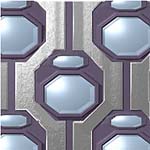 Fuji announces CCD dynamic range breakthrough! (UPDATED)
Fuji announces CCD dynamic range breakthrough! (UPDATED)
By
Dave Etchells
(Tuesday, January 21, 2003 - 21:27 EST)
Announcing their "Fourth-Generation" Super CCD technology, Fuji has revealed what looks like a breakthrough in dynamic range for CCD sensors. The new approach cleverly trades off resolution for dramatically improved dynamic range, offering as much as a 400% improvement in highlight "headroom" relative to conventional technologies.
With each new generation of CCDs that hit the market, digital imaging gets closer and closer to matching film on the basis of resolution. One area where film has had a decisive advantage for some time though, has been the realm of dynamic range: The range of light to dark values that can successfully be recorded. At the root of the problem is that CCDs are essentially linear devices, with a hard limit on the range of illumination they can accurately respond to. Once a CCD's charge wells are full, it stops responding to incremental exposure. If the subject gets any brighter, there's no change in the amount of charge stored by the CCD. This is very different than the way film responds to increasing exposure. Even slide film (which digital sensors are often compared to) offers some differential response to increasing illumination beyond that required to fully expose the film. 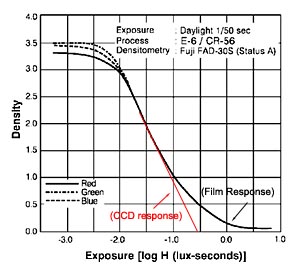
The illustration above shows how typical transparency (slide) film responds to light. (This and all other illustrations here are courtesy of Fujifilm. Modifications made to them are copyright Imaging Resource, and may not be reproduced without the permission of IR.) This is the so-called "DlogE" curve for Fuji's own Sensia 100. The vertical axis shows the density (opacity) of the film, while the horizontal axis shows the exposure level. As you'd expect for slide film, the density is the lowest when the exposure is the highest. Graphs of this sort are referred to as the "Characteristic Curves" of the film involved. What's interesting about characteristic curves of film emulsions is the way they "tail off" at both high and low exposures. Looking at the highlight (righthand) end of the curve, you can see that it flattens out quite a bit as you get to high exposure levels. This means that the film begins responding more gradually to changes in exposure, and as a result can manage to continue to show at least some response at much higher light levels than it would otherwise. By comparison, CCDs are "linear" throughout their range, with the result that they respond very predictably up to a certain light level, but then stop responding altogether at levels higher than that point. I've drawn-in an example of what a CCD's response would look like in red on the chart above. This limitation of CCDs is well-known, but there are things camera designers can do to minimize it. This is why I have that horribly-lit "outdoor portrait" shot in my standard test suite, to evaluate how well cameras handle light overloads in strong highlights. Almost anything you might do to improve a CCD's tolerance for overexposure will have undesirable effects in other areas of its performance, however, so there's no way with conventional CCD technology to match film's tonal response without arriving at a cure that's worse than the problem. Now comes Fuji though, with a very clever approach to the problem. Rather than try to engineer a single CCD sensor to match the broad dynamic range of film, they've instead added a second, low sensitivity sensor to each pixel of the CCD array. The resulting cells look something like the illustrations below. 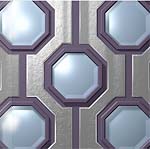 |  | | Standard ("HR") SuperCCD pixel layout. | Dual-Element "SR" SuperCCD pixel structure. |
While it sounds counterproductive to add a reduced-sensitivity sensor to the CCD array, it turns out to be just what's needed to mimic the exceptional dynamic range of film. (Fuji's press release points out that this is actually exactly how film emulsions work, using a combination of high- and low-sensitivity layers to respond to varying levels of exposure.) The low-sensitivity sensor is designed to have a light sensitivity only a quarter that of the main element. This means that it can tolerate light overloads 400% higher than can the main sensor element, without saturating (ceasing to respond). Fuji calls the new, lower-sensitivity sensor elements the "R" pixels, and the larger, more sensitive elements the "S" pixels. With a little clever post-processing, the camera can combine the output signals from the two sensor elements, to mimic the long "tail" on film's DlogE characteristic curve. The illustration below shows how this works. 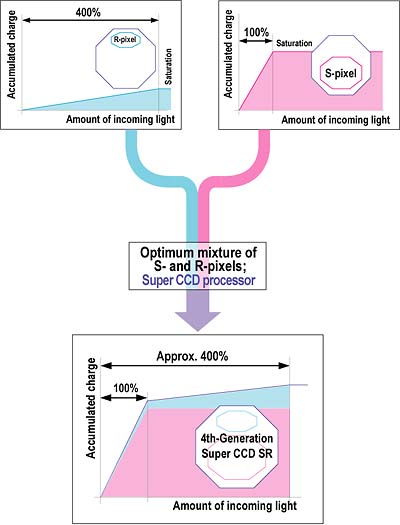
In this schematic depiction of the technique, the resulting curve doesn't look much like a conventional DlogE curve, but the effect is much the same. The sensor can continue to provide a proportional response even in the face of as much as a 400% light overload. The result is that cameras using the new "SR" SuperCCD sensor approach should do a much better job of holding highlight detail under high-contrast lighting conditions. The photos below show what this might look like in an actual image. (Note though, that as far as I know, these images are mockups, and do not represent the actual output from a SR-design SuperCCD.) 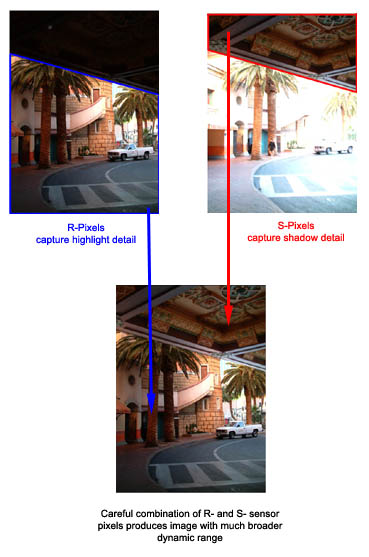
In the shot above, notice how the detail in the overhanging roof is preserved by the "S" pixels, while detail in the brighter portions of the image are recorded by the "R" pixels. (Fuji has promised us some actual sample images captured by prototype "SR" type SuperCCDs, but couldn't get them to us in time for the official announcement of the technology and this article's publication.) To my mind, this is a huge breakthrough, in terms of extending the ability of digital cameras to deal with adverse lighting conditions. More than most digicam innovations, it holds the potential to really impact the picture-taking of the average consumer. - Just think of how many washed-out, pasty faces you've seen in flash shots, or how often you've tried to take shots in full sun (like my "Outdoor Portrait" torture test) with unappealing results. Fuji's development of the SR SuperCCD technology is a bold move for another reason as well: While the industry as a whole has been engaged in a race to cram ever-more pixels onto each chip, the further we go in that direction, the less perceptible the benefit is for the average consumer. The move from 3 to 4 or even 5 megapixels has made relatively little difference in the picture quality enjoyed by the average consumer. While it's true that a 5-megapixel camera lets you crop your shots more than you can manage with a 3-megapixel one, this is a moot point for the average consumer, who rarely manipulates their images. With the SR technology, Fuji is breaking away from the blind pursuit of ever-higher pixel counts, and instead trading off some of that resolution to provide better quality photos with more tonal information in them. Thus, I suspect that even some "enthusiast" shooters would happily trade away some resolution if it meant being able to hold onto more critical subject detail in highlight areas. (In fact, the "enthusiast" crowd may very well become the most enthusiastic adopters of Fuji's SR technology. Of course, as with any fundamentally new technology announcement, we wont' be able to tell how it will play out in practice until we can see it reduced to practice, in production-level products we can test and evaluate. Fuji's press release (see below) mentions sample specs for a planned SR-equipped camera, but at this point they're not announcing any specifics relative to time or price, or features beyond those listed in the release. (Roughly a 3.1 megapixel resolution, with equal numbers of S- and R-pixels, on a 1/1.7" SuperCCD chip.) To stretch a paraphrase a bit, the proof of this particular pudding will be in the shooting, and we won't get to do that for some while yet. In the meantime though, I highly applaud Fuji's bold move to step out of the mindless megapixel race and turn their attentions and engineering expertise to the critical issues of tonal quality and dynamic range. Here's hoping they're successful in bringing SR technology to market, and that it will spark similar innovation by other camera manufacturers. --- OH - and not to totally ignore the other half of Fuji's announcement today, they've also continued to push on in the resolution race as well, with their "Super CCD HR" sensor, a 6.63 megapixel design built on a 1/1.7" chip. This means that Fuji cameras such as the S602 will now be able to go to a full 6 megapixel uninterpolated resolution... ---
UPDATED 2003-01-22 01:30ET: Full US press release added.
|
Original Source Press Release:
| FUJI PHOTO FILM U.S.A., INC. ANNOUNCES FOURTH-GENERATION SUPER CCD TECHNOLOGY Leading-edge digital camera device reaches new frontiers in film-like image quality
ELMSFORD, NY, January 22, 2003 - Fuji Photo Film U.S.A., Inc. today reached a new landmark in the industry's quest for a perfectly life-like digital image. Its proprietary Super CCD technology has created new standards for exceptional digital camera imaging quality since 2000. Now, its fourth-generation devices provide increased resolution, and extended dynamic range, creating for the first time pictures that can begin to match those taken with film. The technology will be marketed under two names - Super CCD HR and Super CCD SR - and will appear in products later this year.
Super CCD HR - High Resolution
The new Super CCD HR (high resolution) announced today incorporates a total of 6.63 million pixels into a 1/1.7" chip, performance made possible through new strides in miniaturization. Cameras equipped with this imaging device can produce up to 12.3 million recording pixels, resulting in remarkably high-resolution images.
Super CCD SR - Super Dynamic Range
Incorporating the same miniaturization technology as the HR version, the Super CCD SR also features a new configuration that produces approximately four times wider dynamic range than third-generation Super CCD. Also measuring 1/1.7" in size, the new Super CCD SR incorporates 6.7 million total pixels (3.35 million S-pixels and 3.35 million R-pixels). Super CCD SR produces a smooth and wide tonal range without losing detail in dark areas or washing out in bright areas.
"These fourth-generation Super CCD technologies represent a monumental change in the way that digital cameras read the data available in scene composition and translate that information into truer-to-film image quality," said Darin Pepple, Brand Manager of Consumer Digital Imaging Products, Consumer Markets Division, Fuji Photo Film U.S.A., Inc. "Super CCD HR and SR bring us closer than ever to reaching the same image quality with digital as with film, especially when images are printed at retail."
Why Super CCD?
Based on almost 70 years of photographic experience and technology expertise, Fujifilm recognizes the importance of resolution, sensitivity and dynamic range as factors that determine overall image quality. Super CCD, which Fujifilm developed in 1999 and introduced to the international marketplace in 2000, aimed for a balance of these enhanced performance factors. The second-generation Super CCD, introduced in 2001, focused on enhancing resolution even further. Next, the third-generation Super CCD, introduced in 2002, successfully boosted light sensitivity. Now, the new fourth-generation Super CCD HR offers significantly enhanced resolution, while the new Super CCD SR delivers greatly expanded dynamic range.
In recent years, the industry's race to boost pixel counts has resulted in ever-smaller pixels incorporated in greater numbers without increasing chip size. In the new Super CCD HR, each pixel has been miniaturized, resulting in a total of 6.63 million total pixels in a 1/1.7" CCD. Cameras equipped with this device produce a remarkable 12.3 million recording pixels. A 1/2.7" version of the Super CCD HR incorporates 3.14 million total pixels, for 6.0 million recording pixels. In addition to greatly enhanced resolution, sensitivity has also improved over the third-generation technology.
In addition to the pixel race, the industry has pursued the creation of digital image quality that approaches that of photographic film, and has approached this problem by increasing resolution and boosting sensitivity. To date, however, among the most important image quality characteristics, even the performance of Fujifilm's previous Super CCDs fell short of film in the area of tonal range. While the pursuit of digital image quality that matches film continues to be the industry's aspiration, Fujifilm's new Super CCD SR technology is an important step in making that goal a reality.
Traditional digital cameras have difficulties reproducing high-contrast images containing both dark and bright areas, with dark areas tending to lose detail and whites washing out. Fujifilm's Super CCD was designed so that the photodiodes in each pixel could be larger, enhancing sensitivity and expanding dynamic range. The newly developed, 4th-Generation Super CCD SR achieves a dynamic range approximately four times greater than its predecessor, and which produces a smooth and wide tonal range without losing detail in dark areas or washing out in bright areas.
The Super CCD SR incorporates both large, high-sensitivity S-pixels and smaller R-pixels for expanded dynamic range. By combining data from both sensor elements according to the composition of the scene, the Super CCD SR is able to deliver both high sensitivity and expanded dynamic range.
A world leader and technology pioneer in digital cameras and their component technologies, Fujifilm will continue to introduce innovative solutions to constantly expand and improve the horizons of digital imaging quality.
About Super CCD:
Fujifilm developed its proprietary Super CCD technology in 1999. The diagonal pixel array of conventional interline CCDs was rotated 45 degrees to form an interwoven configuration of large, octagonal photodiodes, combined with proprietary signal processing to create an integrated imaging system. Highly sensitive to incoming light, this innovative system offered a balanced combination of resolution, sensitivity, dynamic range, signal/noise ratio, and color fidelity, which ushered in a new era in high-quality digital camera imaging.
The principle behind the interwoven array of octagonal pixels was recognized in 2001 with the prestigious Walter Kosonocky Award for significant advances in solid state imaging sensors. A subsequent generation of Super CCD technology was developed in 2001, offering an increase in the number of pixels and reduction in noise to achieve sharper image quality. A third-generation Super CCD technology was developed in 2002. That version combined high-quality VGA-sized 30 frames/second movie recording function with a new image-processing algorithm that produces an ISO 1600 sensitivity.
About Fujifilm
Fuji Photo Film U.S.A., Inc. is the U.S. marketing subsidiary of Fuji Photo Film Co., Ltd. of Tokyo (FUJIY), a leading global manufacturer in three business segments, including Imaging Solutions, Information Solutions and Document Solutions. Recognized for its technological innovation and high
quality, Fujifilm offers a complete portfolio of imaging, information and document products, services and e-solutions to retailers, consumers, professionals and business customers.
The complete Fujifilm product portfolio in the U.S.A. includes: professional and consumer film and cameras; digital imaging products, including cameras and printers for commercial and consumer use; digital minilabs and kiosks; photographic paper and photofinishing supplies; professional motion picture film; high-capacity floppy disks, CDs and DVDs, tape cartridges and other data storage media; videotape and audiocassettes; professional and consumer optical discs; microfilm and other micrographic products; and graphic arts film, conventional and digital printing plates, analog ad digital color proofing systems, drum and flatbed scanners, imagesetters and computer-to-plate systems. Fujicolor Processing, Inc., a subsidiary of Fuji Photo Film U.S.A., Inc., provides wholesale photofinishing through a network of laboratories across the country. Fujifilm e-Systems is a subsidiary of Fuji Photo Film U.S.A., Inc., that develops workflow solutions to support the company's photofinishing labs and consumer photographic businesses, including online imaging services such as Fujifilm.net.
For more information on Fujifilm products, consumers can call 800-800-FUJI or access the Fujifilm USA Web site at www.fujifilm.com.
# # #
All product and company names herein may be trademarks of their registered owners.
Super CCD SR Structural Diagram

Analogy between film and Super CCD SR

Silver halide film is coated with crystals of various shapes- highly sensitive grains with large surface areas that respond to small amounts of light, and low sensitivity grains with small surface area that responds to large amounts of light. The Super CCD SR achieves a similar division of labor by mixing low-sensitivity and high-sensitivity pixels.
4th-Generation Super CCD-equipped camera specs (planned)
| | Super CCD HR-equipped camera | Super CCD SR-equipped camera | | Effective pixels | 6.35 million | 6.2 million (3.1 million S-pixels +3.1 million R-pixels) | | Image sensor | 1/1.7" Super CCD HR 6.63 million total pixels | 1/1.7" Super CCD SR 6.7 million (3.35 million S-pixels +3.35 million R-pixels) total pixels | | Number of recorded pixels | Max. 4048 x 3040 (12.3 million) | Max. 2832 x 2128 (6.03 million) | | Sensitivity | ISO 200 - 1600 (at ISO 1600, in 1280 x 960 pixel mode) | | A/D conversion | 12 - 14 bits | 14 bits | | Dynamic range | Same as existing Fujifilm digital cameras with 3rd generation Super CCD | Approximately 4x (vs. existing Fujifilm digital cameras with 3rd generation Super CCD) | | Movie | 30 frames/second in VGA size |
|
Powered by Coranto
|